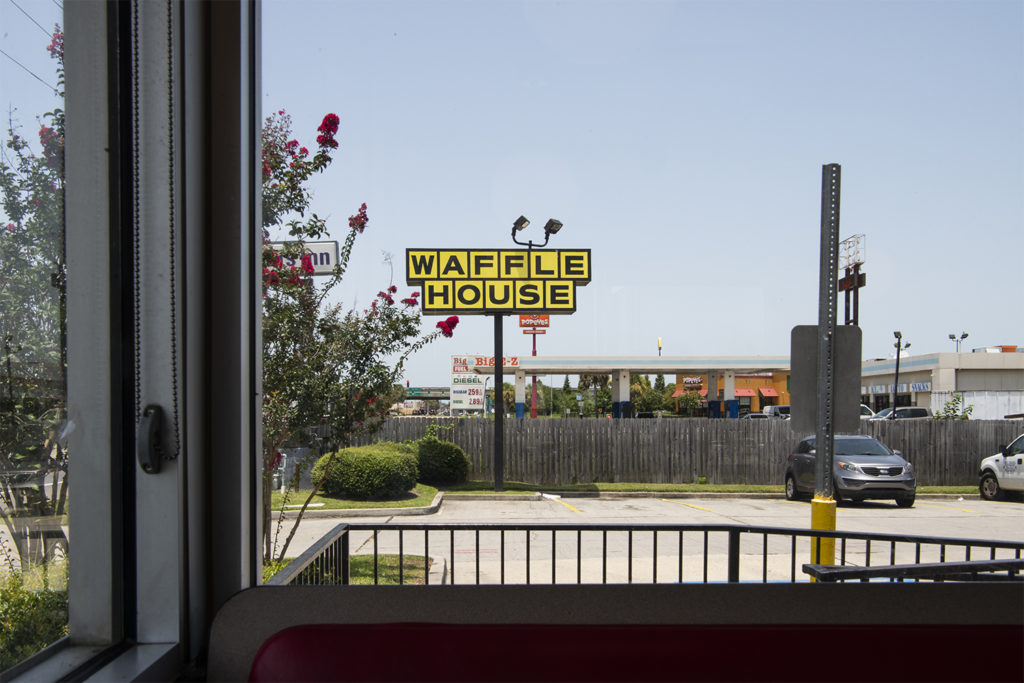Scattered, Smothered, and Covered

When I moved to Knoxville, Tennessee in 1997, it didn’t take long for me to be exposed to one of the best things about the South: Waffle House. It’s not that Waffle House food is particularly great, though there is a place in the world for eggs, hash browns, and toast, competently done, for a low price. It’s that it is the ultimately comfort institution, one that openly caters to working-class people of all races without any pretense while creating a space that people seem fairly comfortable being together with others who are different than them, though very much not without recent racial incidents taking place in them, a sign of the resurgent racism across the country. That they are all institutionally clean doesn’t hurt. Anyway, this is a good photo essay about the views from various Waffle House joints and what it means to the South.
Why Waffle House? Why not McDonald’s or Hardee’s? Three reasons: consistency, personal relationship, and the chain’s iconic status.
I felt that I needed a constant from which to study our built environment, and the relative sameness of Waffle House restaurants allowed me that ability. Whether you like it or not, Waffle House is your neighborhood diner, replicated thousands of times over. The restaurants are relatively the same, architecturally speaking, as are the menu, the prices, and the experience. This replication of experience was the conceptual underpinning of this project, and that repetition is illustrated in the images.
While the interiors would vary depending on the age of the restaurant, the signifiers that these photographs are made from within Waffle Houses are consistent: the iconic globe lights, the red vinyl booths, the semi-opaque blinds and their beaded chains, the identical tabletop arrangements. Those elements were constant wherever I went, as was the service. I visited approximately 60 restaurants in nine different states and never once had a bad experience. Sometimes my bacon was undercooked or I was served white toast instead of wheat, but I was never treated poorly, nor was anyone else.
Second, nearly every Southerner feels a personal connection to Waffle House. How can a cookie-cutter restaurant chain win over the hearts of millions of people? My answer is inclusivity. In my experience, when you walk into a Waffle House, whether it is off a random exit in northern Alabama or downtown Charlotte, North Carolina, you are welcomed. At its best, Waffle House creates a sense of belonging unlike most other places.
Waffle House does not care how much you are worth, what you look like, where you are from, what your political beliefs are, or where you’ve been so long as you respect the unwritten rules of Waffle House: Be kind, be respectful, and don’t overstay when others are waiting for a table. Besides, everyone who has ever stepped foot in a Waffle House has a story to tell: Perhaps it involves a late-night study session in college or a joyous pit stop on the way home from a concert or sporting event. Maybe it was a bad breakup over waffles or an early morning breakfast with your bridal party before your wedding. For me, it is the first time my son tried a chocolate chip waffle. The look on his face when he realized that chocolate and syrup taste great together was one of pure delight and discovery. Or the first time my father took me to a Waffle House around the age of 12. I sat at the counter mesmerized, watching the cooks sling hash browns and respond to shouted orders in what seemed like a secret language. These photographs require that personal relationship. I don’t set the stage for where these photographs are made so much as I witness the greater context of the interaction. Instead, the circumstances are gleaned from the viewer’s past experiences and personal relationship with Waffle House
….
I began this work because I have had a long-standing interest in witnessing, understanding, and pushing back against the economic and governmental structures that segregate us by race and class. That might seem extreme, but I have long argued we can see how we treat and value each other by merely looking out the window. The proof is in our tax codes, zoning laws, and businesses. That was the impetus for this project: What do I see and what does it mean? What is the architecture of poverty? I don’t mean the extreme poverty fetishized every few months in the mainstream media, but the more common poverty that hides in plain sight. The people who live paycheck to paycheck. The families who pay more for their childcare than their mortgage or rent. The commuters who ride public transit for two hours to work a job that is a mere 15 miles away. This country is full of people who work hard yet are forced to work multiple jobs because none pays a living wage, yet those in charge consistently suggest to us that we’re lucky to have such jobs. Those jobs are plentiful, but undesirable. My swing through Kentucky and western Tennessee in mid-December of 2018 was proof of this. It seemed every other fast food establishment in both states had a “Now Hiring” sign displayed. It isn’t a coincidence that most of the businesses captured in these photographs are fast food restaurants and low-end motels. This is not a critique of Waffle House as a corporation — good, inexpensive food that is prepared fast, 24 hours a day, is a desired commodity. But Waffle House’s business model overlaps with those of discount stores such as Dollar General, extended stay motels aimed at families without a steady place to live, and payday lenders.
Whole thing, as they say, is well worth reading.


